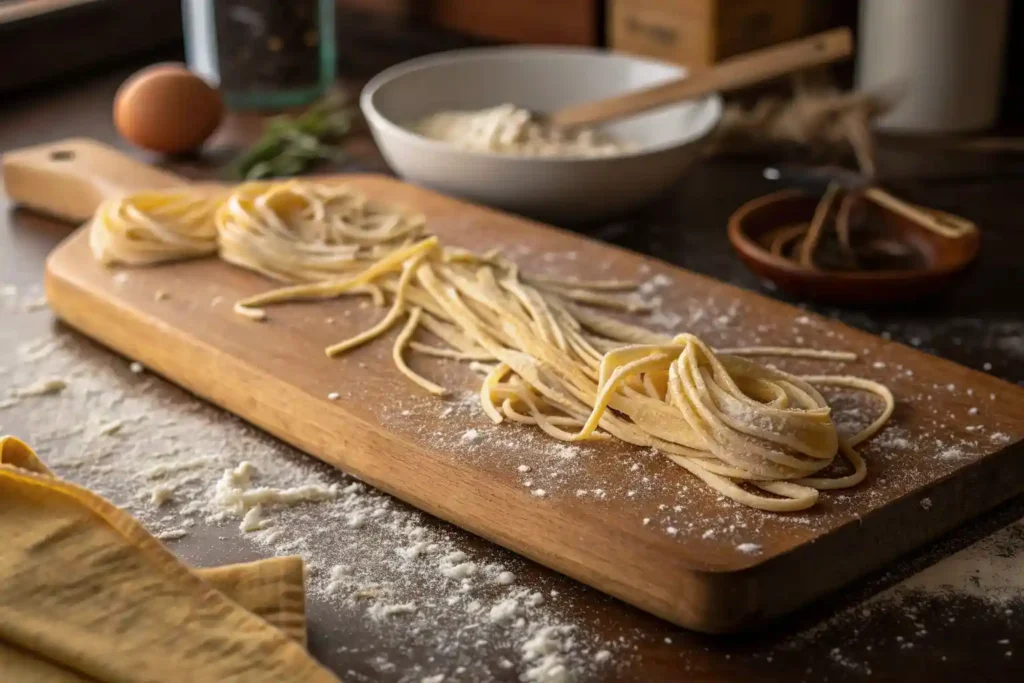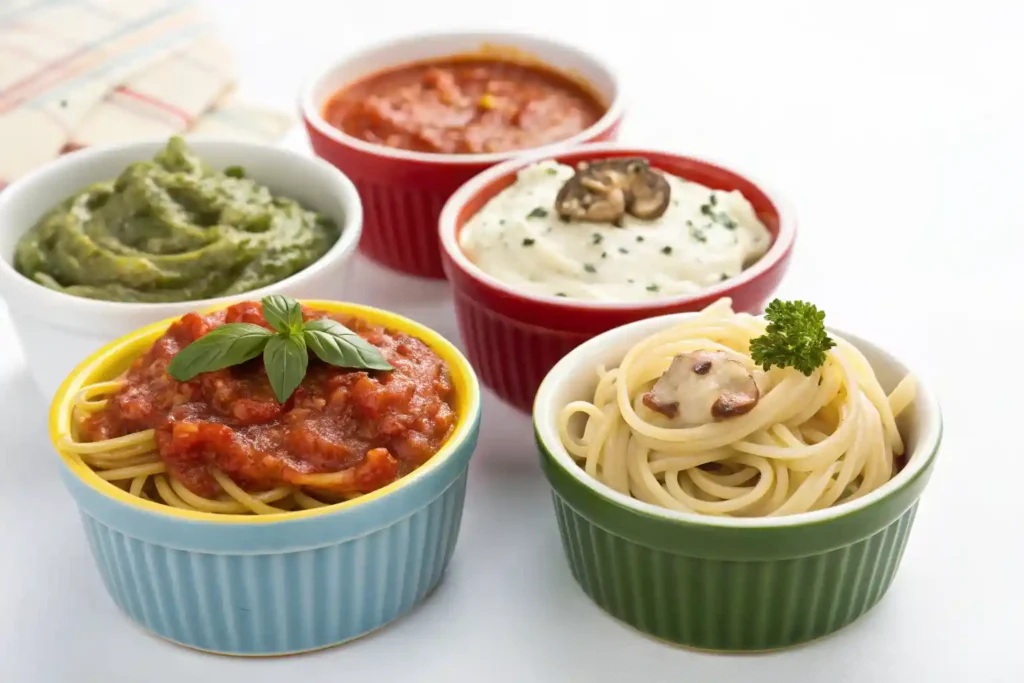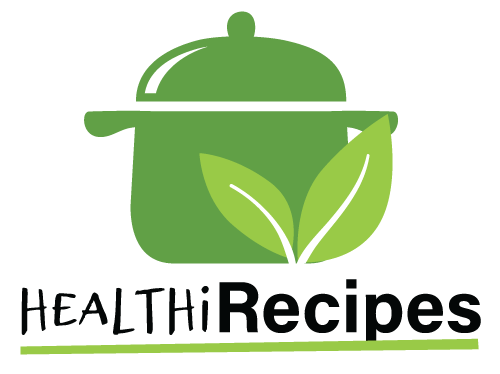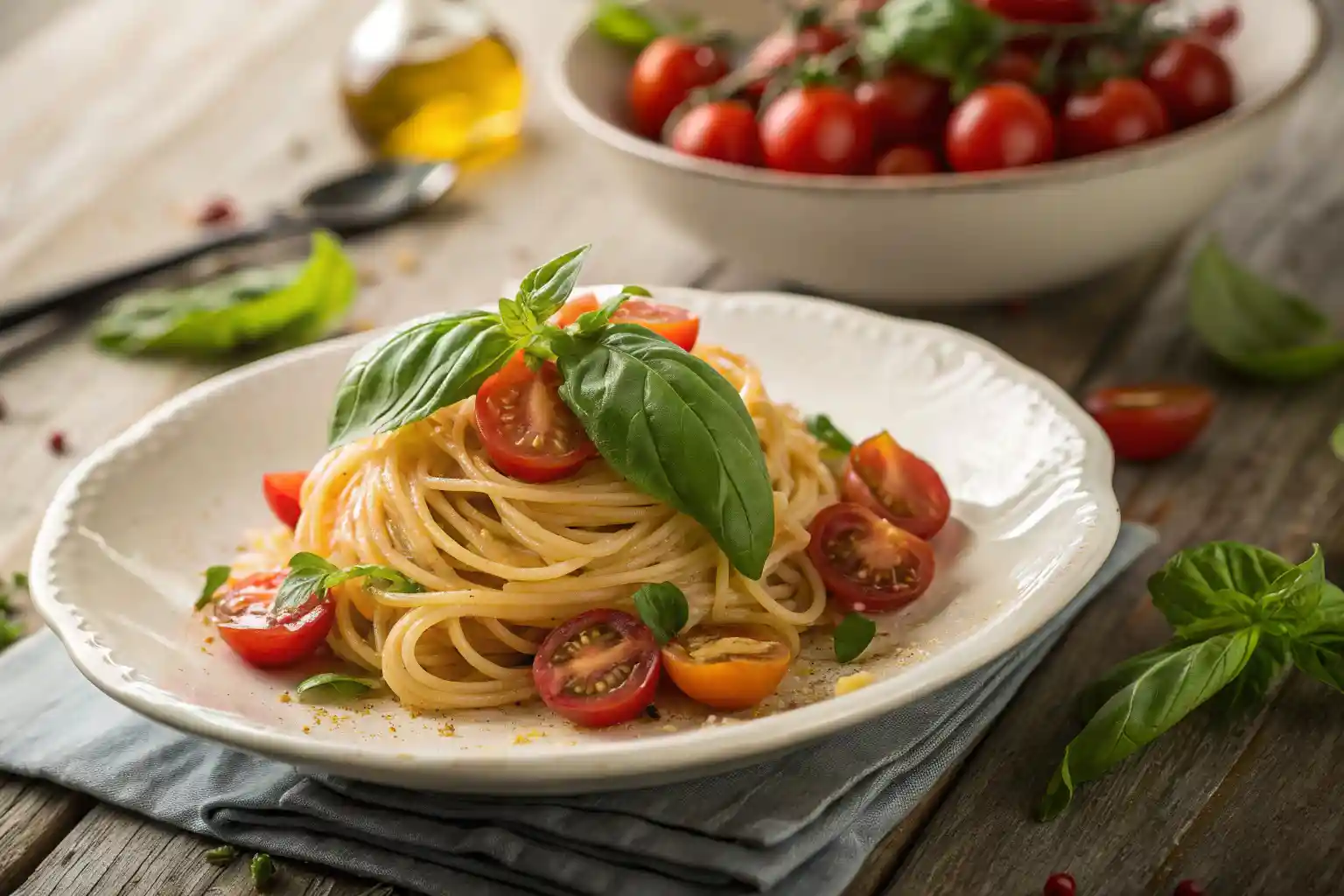Chitarra pasta is a delightful and unique type of Italian pasta that brings a taste of tradition right to your kitchen. In this article, we’ll explore everything you need to know about chitarra pasta, from its rich history and distinctive characteristics to how to make it from scratch and the best sauces to pair with it. Whether you’re a seasoned chef or a curious beginner, this guide will help you master the art of cooking perfect chitarra pasta every time. So, let’s dive in!
Table of contents
1: Introduction to Chitarra Pasta
What is Chitarra Pasta?
Chitarra pasta, often referred to as chitarra noodles, is a traditional Italian pasta that hails from the Abruzzo region. The name “chitarra” translates to “guitar” in Italian, which is quite fitting. This pasta is made using a special wooden tool that resembles a guitar, featuring strings that cut the dough into square-shaped strands. The result? A pasta that’s not only visually appealing but also has a unique texture that holds sauces beautifully.
The History of Chitarra Pasta
The origins of chitarra pasta date back to the 19th century, where it was crafted by hand in Italian kitchens. Traditionally, it was made with simple ingredients: flour, eggs, and a pinch of salt. Over the years, this pasta has gained popularity beyond its regional roots, becoming a staple in many Italian households and restaurants worldwide. Its versatility allows it to be paired with a variety of sauces, from rich meat sauces to light vegetable-based ones.
Chitarra pasta is more than just a dish; it’s a piece of Italian heritage that reflects the country’s culinary traditions. As we continue through this article, you’ll discover how to make this delightful pasta at home, ensuring that you can enjoy its authentic taste anytime you wish. So, let’s move on to explore the unique characteristics of chitarra pasta!
2: The Unique Characteristics of Chitarra Pasta

Texture and Shape of Chitarra Pasta
One of the standout features of chitarra pasta is its unique texture and shape. Unlike other pasta types, chitarra is square-shaped, which allows it to hold onto sauces exceptionally well. This shape is achieved by pressing the dough through a special tool that has strings, resembling a guitar. The result is a pasta that’s slightly thicker than spaghetti, giving it a delightful bite.
When cooked, chitarra pasta has a firm texture that makes it perfect for various dishes. It’s often described as having a “toothsome” quality, meaning it has a satisfying chew that enhances the overall eating experience. This texture is ideal for pairing with rich sauces, as it clings beautifully, ensuring every bite is packed with flavor.
Ingredients Used in Chitarra Pasta
The ingredients for making chitarra pasta are simple yet essential. Typically, you’ll need durum wheat flour, which is high in protein and gives the pasta its structure. Many recipes also call for eggs, which add richness and color to the dough. Some variations might include water or olive oil, depending on the desired texture.
Using high-quality ingredients is crucial for achieving the best results. Fresh eggs and premium flour can make a significant difference in the final product. Additionally, some cooks like to experiment with different flours, such as semolina or whole wheat, to create unique flavors and textures.
In summary, the unique characteristics of chitarra pasta, from its shape to its ingredients, make it a versatile choice for many dishes. Now, let’s move on to the exciting part: how to make chitarra pasta from scratch!
3: How to Make Chitarra Pasta from Scratch
Essential Tools for Making Chitarra Pasta
Making chitarra pasta at home is a rewarding experience, and having the right tools can make the process much easier. Therefore, here’s what you’ll need:
Chitarra Board: This is the special tool used to cut the pasta. It has strings stretched across a wooden frame, allowing you to create the signature square shape.
Rolling Pin: A good rolling pin is essential for flattening the dough to the right thickness. In addition, it helps ensure that the dough is evenly rolled out.
Mixing Bowl: You’ll need a large bowl to mix your ingredients. On the other hand, if you don’t have a large bowl, you might find it challenging to combine everything properly.
Flour for Dusting: Keep some extra flour on hand to prevent the pasta from sticking. Thus, having enough flour will make the process smoother and more enjoyable.
Step-by-Step Guide to Making Chitarra Pasta
- Prepare the Dough: In a mixing bowl, combine 2 cups of durum wheat flour and a pinch of salt. Make a well in the center and crack in 2 large eggs. Using a fork, beat the eggs and gradually incorporate the flour until a dough forms.
- Knead the Dough: Transfer the dough to a floured surface and knead it for about 10 minutes until it’s smooth and elastic. If the dough is too sticky, sprinkle a little more flour as needed.
- Rest the Dough: Wrap the kneaded dough in plastic wrap and let it rest for at least 30 minutes. This allows the gluten to relax, making it easier to roll out.
- Roll Out the Dough: After resting, divide the dough into smaller portions. Using a rolling pin, roll each portion out to about 1/8 inch thick. Dust with flour to prevent sticking.
- Cut the Pasta: Place the rolled-out dough on the chitarra board. Using a rolling pin, press down firmly to cut the pasta into square strands. Gently lift the pasta off the board and dust with flour to keep it from sticking together.
- Cook the Pasta: Bring a large pot of salted water to a boil. Add the chitarra pasta and cook for about 3-4 minutes, or until al dente. Fresh pasta cooks much quicker than dried pasta, so keep an eye on it!
Common Mistakes to Avoid When Making Chitarra Pasta
While making chitarra pasta is straightforward, there are a few common pitfalls to watch out for:
- Not Kneading Enough: Ensure you knead the dough well to develop the gluten, which gives the pasta its structure.
- Skipping the Resting Period: Don’t rush this step! Allowing the dough to rest is crucial for easy rolling.
- Overcooking the Pasta: Fresh pasta cooks quickly, so taste it a minute or two before the suggested cooking time.
4: Cooking Chitarra Pasta Perfectly
How to Cook Chitarra Pasta Al Dente
Cooking chitarra pasta to perfection is all about timing and technique. To achieve that delightful al dente texture, follow these simple steps:
- Boil the Water: Start by bringing a large pot of salted water to a rolling boil. The salt not only flavors the pasta but also helps to enhance its texture.
- Add the Pasta: Once the water is boiling, gently add your freshly made chitarra pasta. Stir it gently to prevent the strands from sticking together.
- Timing is Key: Fresh chitarra pasta cooks much faster than dried pasta. Typically, it will take about 3 to 4 minutes to reach that perfect al dente state. To check for doneness, taste a strand. It should be firm to the bite but not hard.
- Reserve Pasta Water: Before draining the pasta, save about a cup of the cooking water. This starchy water can be a game-changer when mixing your pasta with sauce, helping to create a silky texture.
- Drain and Rinse: Drain the pasta in a colander, but avoid rinsing it. Rinsing removes the starch that helps sauces cling to the pasta.
Best Practices for Boiling Chitarra Pasta
To ensure your chitarra pasta turns out perfectly every time, keep these best practices in mind:
- Use Plenty of Water: A large pot with plenty of water allows the pasta to move freely, preventing it from sticking together.
- Don’t Overcrowd the Pot: If you’re making a large batch, consider cooking the pasta in batches. Overcrowding can lead to uneven cooking.
- Taste as You Go: Since cooking times can vary, tasting the pasta a minute or two before the suggested time is essential. This way, you can catch it at just the right moment.
5: Delicious Sauces to Pair with Chitarra Pasta

Traditional Sauces for this pasta
Chitarra pasta is incredibly versatile and pairs well with a variety of sauces. Therefore, here are some traditional options that highlight its unique texture:
Classic Tomato Sauce: A simple marinara made with fresh tomatoes, garlic, and basil is a timeless choice. In addition, the acidity of the tomatoes balances beautifully with the richness of the pasta.
Bolognese Sauce: This hearty meat sauce, made with ground beef, pork, and a mix of vegetables, clings perfectly to this pasta. Thus, the robust flavors create a satisfying meal that’s perfect for family gatherings.
Aglio e Olio: For a quick and easy option, sauté garlic in olive oil and toss in some red pepper flakes. On the other hand, this simple sauce allows the flavor of the chitarra pasta to shine through without overwhelming it.
Creative Sauce Ideas for this pasta
If you’re looking to get a bit more adventurous, here are some creative sauce ideas to try:
Pesto Sauce: A vibrant basil pesto made with fresh basil, pine nuts, garlic, and Parmesan cheese adds a burst of flavor. Therefore, toss the cooked pasta with pesto and a splash of reserved pasta water for a creamy finish.
Creamy Mushroom Sauce: Sauté mushrooms and garlic in butter, then add cream and Parmesan for a rich, indulgent sauce. Consequently, this pairs wonderfully with the texture of this pasta.
Seafood Sauce: Combine shrimp, scallops, and a splash of white wine for a light and flavorful seafood sauce. Moreover, the brininess of the seafood complements the pasta beautifully.
Vegetable Medley: For a lighter option, sauté seasonal vegetables like zucchini, bell peppers, and cherry tomatoes. In addition, toss them with olive oil and herbs for a fresh, healthy dish.
6: Chitarra Pasta Recipes to Try
Classic Chitarra Pasta with Tomato Sauce
One of the simplest yet most satisfying ways to enjoy this pasta is with a classic tomato sauce. Here’s how to make it:
Ingredients:
- 2 cups of chitarra pasta
- 1 can (28 oz) of crushed tomatoes
- 2 cloves of garlic, minced
- 1 onion, chopped
- 2 tablespoons of olive oil
- Fresh basil leaves
- Salt and pepper to taste
Instructions:
- Cook the Pasta: Start by boiling the chitarra pasta in salted water until al dente, as discussed earlier.
- Make the Sauce: In a large skillet, heat the olive oil over medium heat. Add the chopped onion and sauté until translucent. Then, add the minced garlic and cook for another minute.
- Add Tomatoes: Pour in the crushed tomatoes, season with salt and pepper, and let it simmer for about 15 minutes. Stir in fresh basil just before serving.
- Combine: Toss the cooked pasta with the sauce, adding a splash of reserved pasta water if needed to help the sauce cling.
This dish is not only easy to make but also highlights the wonderful texture of chitarra pasta.
Pasta with Pesto and Vegetables
For a fresh and vibrant meal, try this pasta pasta with pesto and seasonal vegetables. Here’s a quick recipe:
Ingredients:
- 2 cups of chitarra pasta
- 1 cup of basil pesto (store-bought or homemade)
- 1 zucchini, sliced
- 1 bell pepper, chopped
- 1 cup of cherry tomatoes, halved
- Olive oil
- Salt and pepper to taste
Instructions:
- Cook the Pasta: Boil the until al dente.
- Sauté the Vegetables: In a skillet, heat a bit of olive oil over medium heat. Add the zucchini and bell pepper, cooking until tender. Toss in the cherry tomatoes and cook for another minute.
- Combine: Drain the pasta and add it to the skillet with the vegetables. Stir in the pesto, mixing well to coat the pasta evenly. Season with salt and pepper to taste.
This recipe is perfect for a light lunch or dinner, showcasing the versatility of this pasta.
Pasta with Seafood
If you’re in the mood for something a bit more indulgent, this pasta pairs beautifully with seafood. Here’s a simple recipe:
Ingredients:
- 2 cups of chitarra pasta
- 1 cup of shrimp, peeled and deveined
- 1 cup of scallops
- 2 cloves of garlic, minced
- 1/2 cup of white wine
- 2 tablespoons of olive oil
- Fresh parsley, chopped
- Salt and pepper to taste
Instructions:
- Cook the Pasta: Boil the pasta until al dente.
- Sauté Seafood: In a skillet, heat olive oil over medium heat. Add garlic and sauté for a minute. Then, add shrimp and scallops, cooking until they turn opaque.
- Add Wine: Pour in the white wine and let it simmer for a few minutes until slightly reduced. Season with salt and pepper.
- Combine: Toss the cooked chitarra pasta with the seafood mixture, adding a bit of reserved pasta water if needed. Garnish with fresh parsley.
This dish is sure to impress your guests and is a fantastic way to enjoythis pasta.
7: Chitarra Pasta vs. Other Pasta Types
What is the Difference Between Spaghetti and Chitarra?
While both chitarra pasta and spaghetti are popular Italian pasta types, they have distinct differences. Spaghetti is long and cylindrical, while chitarra is square-shaped and slightly thicker. This unique shape allows this pasta to hold onto sauces better than spaghetti, making it a preferred choice for heartier dishes.
Chitarra vs. Tonnarelli: Understanding the Differences
Another pasta that often gets compared to chitarra is tonnarelli. Both are similar in shape, but tonnarelli is typically made with a different dough and is slightly thicker. Tonnarelli is often associated with the Lazio region, while chitarra is a staple of Abruzzo. The texture of tonnarelli is a bit more robust, which can affect how it pairs with sauces.
Conclusion
In conclusion, chitarra pasta is a delightful and versatile dish that can elevate any meal. From its unique square shape to its ability to hold sauces beautifully, it’s a pasta that deserves a spot in your kitchen. Whether you choose to pair it with a classic tomato sauce, a vibrant pesto, or even a rich seafood sauce, the possibilities are endless.
As you explore the world of pasta, consider trying other unique shapes like Gigli Pasta: Unique Shape & Delicious Recipes to expand your culinary repertoire. For those interested in exploring the origins and variations of this pasta, you can learn more about its history and production methods by visiting the Wikipedia page on Spaghetti alla Chitarra. This resource provides valuable insights into how this beloved pasta is made and enjoyed across Italy, further enriching your understanding and appreciation of this pasta.
So, gather your tools, choose your favorite sauce, and enjoy the rewarding experience of making and savoring chitarra pasta at home!

